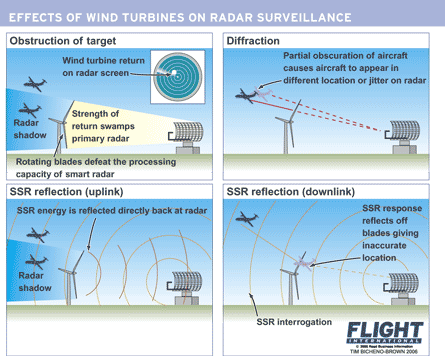By David Learmount in London
Air traffic surveillance can be severely degraded unless planners are required to consider aircraft safety
Wind turbines, especially many grouped in a wind farm, can wipe out the effectiveness of primary and secondary radar surveillance systems and radio navigation aids, says the UK Civil Aviation Authority. In a report, the agency calls on the government to require those responsible for siting wind turbines to consider aviation safety as well as other issues.
“The development of wind turbines has the potential to cause a variety of effects on aviation,” says the CAA report. “These range from physical safeguarding [turbines as tall obstacles], generation of unwanted returns on primary radar, affecting the performance and propagation of secondary surveillance radar [SSR], navigation aids and communication facilities, through to consideration of [air] turbulence. It should be noted that wind turbines do not in themselves cause electromagnetic interference.”

There are multiple ways in which wind turbines can interfere with radar surveillance, especially if they are in groups, in radar line of sight, and located within 28km (15nm) or less of the radar head. According to the CAA the types of interference include:
- Swamping the receivers: this refers to primary radar, and occurs when “the bulk of the wind turbine structure may reflect sufficient energy to swamp any reflected energy of aircraft in the same area”.
- Defeating moving target processing: “If the rotating wind turbine blades are within or close to the radar line of sight, then the Doppler shift in reflected energy from the blades may defeat any moving target processing and display the blades as targets or tracks that could be mistaken for aircraft.”
- Presenting an obstruction: “If the wind turbines are within radar line of sight and aircraft are required to be detected at longer range behind the wind turbines then the following two effects may occur: obstruction – aircraft detection is lost in the shadow of the wind turbines; and diffraction – partial obscuring of the aircraft radar reflections by the wind turbines causes azimuth errors at the radar [so] the aircraft can be displayed in a skewed position, or appears to jitter in position as it passes behind multiple blades.”
- SSR reflections: “SSR energy may be reflected off the structures in both the uplink and downlink directions. This can result in aircraft, which are in a different direction to the way the radar is looking, replying through the reflector and tricking the radar into outputting a false target in the direction where the radar is pointing – in other words, at the obstruction.”
- Navigation aid signal effects: depending on the relative position of the wind farm, it “can affect the propagation of the radiated signal from instrument landing systems. As a result, the integrity and performance of these systems can be unacceptably degraded.”
The CAA says it is researching all these effects more closely and will promulgate further advice.
Source: Flight International























